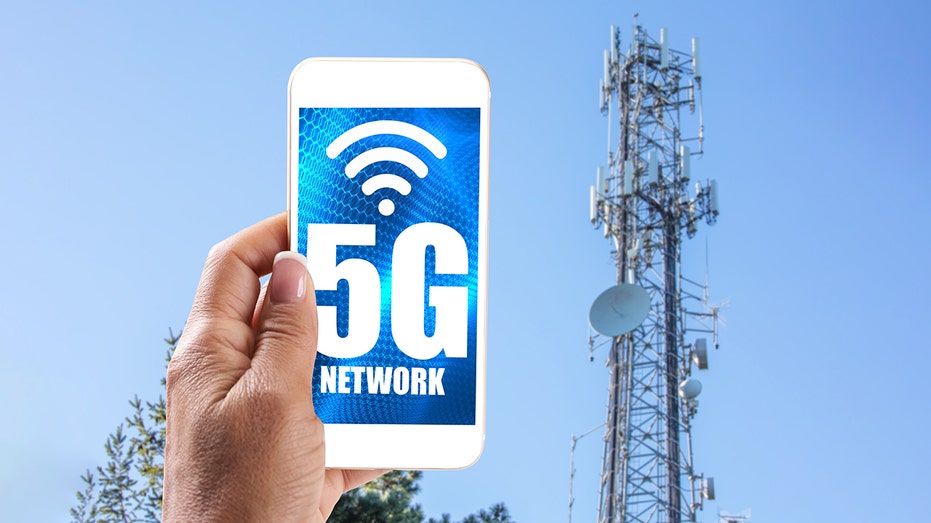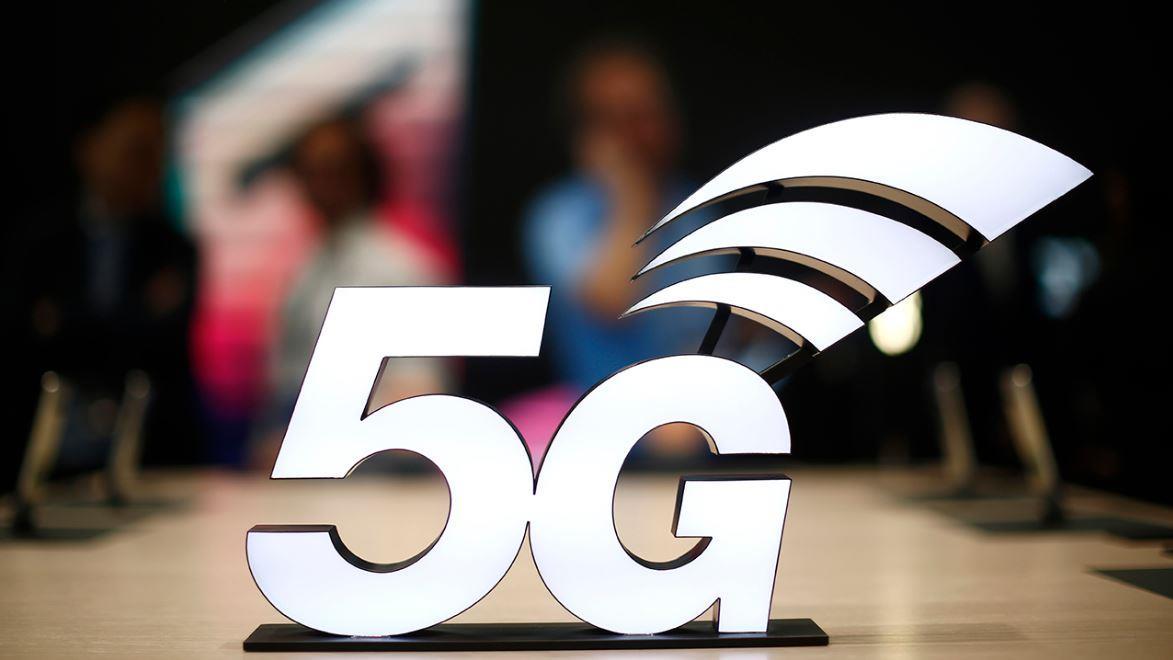What is 5G?
5G is the next big thing in wireless network technology
The term "5G" has been floating around the news in recent weeks, but many people still aren't sure exactly what 5G is or what it has to do with the United States' relationship with China and the U.K.
Fifth-generation, or 5G, technology is the world's latest development in wireless phone service since 4G became the global standard starting around 2009. Before 4G, there were 3G and 2G and so on.
"To put it most simply, 5G is the next big thing in wireless network technology," Matt Kahle, a 5G expert at wireless infrastructure distributor CTI Technologies, told FOX Business. "The main advantage of 5G is speed. The only way to take advantage of 5G is to have a 5G-capable device on a 5G network."

5G logo display at a cellphone store. (Alex Tai/Sopa-images Lightrocket-via Getty Images)
With each new generation of wireless technology comes updated infrastructure and technological developments in terms of what that wireless service can achieve within a select time frame. 5G is expected to help artificial intelligence (AI) technology become more advanced and useful in our everyday lives.
5G RACE FULL-SPEED AHEAD: MISGUIDED ATTEMPT TO NATIONALIZE IS OVER, FOR NOW
Larry Downes, Georgetown University senior industry and innovation fellow, explained the various differences between wireless network generations. Going from 2G to 3G, he said, made phones into devices that could not only make calls but also allow users to browse the internet at faster speeds and download videos. When 4G became available, internet browsing speeds got even faster and video quality improved significantly.
When 4G becomes 5G, Downes explained, self-driving cars will be able to detect other cars and connect to the road, smart homes will be able to connect appliances and lightbulbs to smartphones and networks, and video quality will be better than ever before.
4G technology, which is what the Big Four cellphone companies -- Verizon, AT&T, T-Mobile and Sprint -- use today, allows smartphone users to connect to the internet at rapid speeds through radio waves that send signals between phones and cell towers. 4G is the reason complex, innovative apps like Uber, Dropbox, Office 365, Instagram Live, Snapchat and Slack exist.
5G requires a radiofrequency range that "is significantly higher than traditional 4G [and lower] frequencies, and that’s where the magic exists, resulting in being able to pass a significant amount more data," Kahle explained.
Different aspects of 5G are estimated to be between five and 100 times faster than 4G because it uses higher radiofrequency.
The quality of 5G service, therefore, is also expected to be better in general, meaning service will lag less and the ability to use apps that require a fast internet connection, such as rideshare and video streaming apps, will come easier to those who live in rural areas that struggle with connection due to complications associated with broadband infrastructure, which requires a physical cable connection.
"I personally look at frequencies [in] a couple of different ways," Kahle said. "The easiest is to think about it like the music we listen to. Low frequencies can travel further, but the trade-off is that they carry less data. If someone has an apartment next door to you, and they are watching a movie, you may only hear the lower-bass frequencies through the wall."

Visible 5G panel on a crosswalk signal. (iStock)
"These [lower] frequencies inherently provide limited amounts of data," Kahle explained. "The user understands they are listening to music or watching TV but can’t necessarily discern what is being said or what song it is. On the opposite end of the spectrum, you have higher frequencies [that] can hold a significant amount more data in them, and you can infer much detail when listening to full-frequency audio."
These higher frequencies are only made possible through new infrastructure that is more complicated than 4G infrastructure. 5G will not only require the use of cellphone towers like 4G, it will also require antennas to be put up in neighborhoods across the country that will likely be in close proximity to buildings, as well as more satellites in space.
STEVE MOORE: THE 5G GLOBAL TECHNOLOGY RACE IS VITAL FOR OUR FUTURE
"From an infrastructure standpoint, the way 5G will look is very different," Downes said. "With cellular networks today, we have big towers with big antennas on them. 5G will use that same infrastructure, but for the instantaneous connection, 5G will supplement those towers with lots and lots of antennas on the sides of buildings, on houses, in the ground -- there will be many of them but much less visible than cell towers are."
Some experts say the proximity of these new antennas giving off high-frequency radio waves to buildings create a health and safety concern.
While the extremely short distances that 5G frequencies require to work at full capacity deliver faster internet, it is almost "impossible for these signals to penetrate anything; even rain can make it not work within a couple hundred feet," Kahle said, adding that "there will never be a day that we have complete high-band 5G coverage in the US utilizing these higher frequencies."
"The trickle-down is that cellular companies will continue to improve their 4G equipment on cellular towers and rebrand that as 5G," he said, adding, "Some carriers are rebranding their 4G networks as 5Ge like AT&T, but that’s not really 5G."
Downes expanded on this idea, saying wireless carriers like Verizon, AT&T and T-Mobile are already selling "lite" versions of 5G.
GET FOX BUSINESS ON THE GO BY CLICKING HERE
"What they are selling does make use of a lot of the new infrastructure necessary for 5G," he said but added that "a lot of the software specifications" necessary for real 5G, such as "processing at antennas and cell towers and in the cloud" that will determine the level of wireless service these companies are offering, are not available yet.
"We might have 5G protocols for communication, but the actual network infrastructure isn't there yet," he explained.

Kahle said that in the future, telecom network providers will likely provide low-, mid- and high-band frequencies "to provide an all-around smooth user experience to allow most consumers to communicate with AI on-demand without having concerns of speed restrictions, but physics is physics, and for the immediate future rural areas will still follow far behind due to their towers being less frequent due to low population density."
So, what does all this have to do with China and the U.K.?
China subsidizes a telecom giant called Huawei that offers some of the most advanced and inexpensive 5G technology in the world. The trade-off for using this technology is its alleged connections to China's Communist Party and its ties to Chinese surveillance technology that is used to spy on minority groups like China's Uighur Muslim population.
Additionally, some experts argue that allowing a Chinese-government-subsidized company control over wireless networks could put intelligence and other sensitive information at risk of Chinese theft.
If Huawei is adopted by powerful Western countries like the U.K., which announced Tuesday that it would allow Huawei to build 35 percent of its new 5G mobile network despite U.S. concerns, alternative 5G options developed by other countries could face tough competition by the Chinese.
U.S. companies like Apple, Google, Amazon and other tech giants are all working to make this kind of technology and infrastructure possible in the U.S. so the country does not have to rely on Chinese technology.




















